Статьи журнала - International Journal of Image, Graphics and Signal Processing
Все статьи: 1056
A Novel Object Position Coding for Multi-Object Tracking using Sparse Representation
Статья научная
Multi-object tracking is a challenging task, especially when the persistence of the identity of objects is required. In this paper, we propose an approach based on the detection and the recognition. To detect the moving objects, a background subtraction is employed. To solve the recognition problem, a classification system based on sparse representation is used. With an online dictionary learning, each detected object is classified according to the obtained sparse solution. Each column of the used dictionary contains a descriptor representing an object. Our main contribution is the representation of the moving object with a descriptor derived from a novel representation of its 2-D position and a histogram-based feature, improved by using the silhouette of this object. Experimental results show that the approach proposed for describing moving objects, combined with the classification system based on sparse representation provides a robust multi-object tracker in videos involving occlusions and illumination changes.
Бесплатно
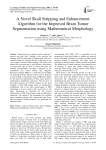
Статья научная
Human brain is a complex system, made up of neurons and glial cells. Nothing in the universe can compare with the functioning of human brain. Due to its complex nature, the diseases affected on the brain is also very complex in nature. Brain imaging is the widely used method for the diagnosing of such deceases. Brain tumor is an abnormal mass of tissue in which cells grow and multiply uncontrollably, seemingly unchecked by the mechanisms that control normal cells. Magnetic Resonance Imaging (MRI) is a commonly used modality for detecting the brain diseases. In this work we proposed a novel method for the preprocessing of MR brain images for the improved segmentation of brain tumor based on mathematical morphology operations. The first part of this paper proposes an efficient method for the skull stripping of brain MR images based on mathematical morphology. One of the main disadvantages of MRI technology is its low contrast. The second part of this paper implements an algorithm for the contrast enhancement of MR brain images using morphological operations. The output of this algorithms are evaluated using standard measures. The experimental part shows that the proposed method produces very prominent and efficient results.
Бесплатно
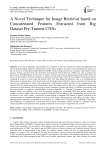
Статья научная
Accessing semantically relevant data from a database is not only essential in commercial applications but also in medical imaging diagnosis. Representation of the query image by its features and subsequently the dataset are the key factors in Content Based Image Retrieval (CBIR). Texture, shape and color are commonly used features for this purpose. Features extracted from the pre-trained Convolutional Neural Networks (CNNs) are used to improve the performance of CBIR methods. In this work, we explore a recent state of the art big dataset pre-trained CNNs which are known as Big Transfer Networks. Features extracted from Big Transfer Network have higher discriminative power compared to features of many other pre-trained CNNs. The idea behind the proposed work is to demonstrate the effectiveness of using features of big transfer networks for image retrieval. Further, features extracted from big transfer networks are concatenated to improve the performance of the proposed method. Feature diversity supplemented with network diversity should ensure good discriminative power for image retrieval. This idea is supported by performing simulations on four datasets with varying sizes in terms of number of images and classes. As feature size increases with the concatenation, we applied a dimensionality reduction algorithm i.e., Principal Component Analysis. Several distance metrics are explored in this work. By properly choosing the pre-trained CNNs and distance metric, it is possible to achieve higher mean average precisions. ImageNet-21K pre-trained CNN and Instagram pre-trained CNN are chosen in this work. Further, a pre-trained network trained on Imagenet-21K dataset is superior compared to the networks trained on ImageNet-1K dataset as there are more classes and presence of wide variety of images. This is demonstrated by applying our algorithm on four datasets i.e., COREL-100, CALTECH-101, FLOWER-17 and COIL-100. Simulations are presented for various precisions (scopes), and distance metrics. Results are compared with the existing algorithms and superiority of the proposed method in terms of mean Average Precision is shown.
Бесплатно
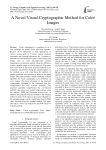
A Novel Visual Cryptographic Method for Color Images
Статья научная
Visual cryptography is considered to be a vital technique for hiding visual data from intruders. Because of its importance, it finds applications in various sectors such as E-voting system, financial documents and copyright protections etc. A number of methods have been proposed in past for encrypting color images such as color decomposition, contrast manipulation, polynomial method, using the difference in color intensity values in a color image etc. The major flaws with most of the earlier proposed methods is the complexity encountered during the implementation of the methods on a wide scale basis, the problem of random pixilation and insertion of noise in encrypted images. This paper presents a simple and highly resistant algorithm for visual cryptography to be performed on color images. The main advantage of the proposed cryptographic algorithm is the robustness and low computational cost with structure simplicity. The proposed algorithm outperformed the conventional methods when tested over sample images proven using key analysis, SSIM and histogram analysis tests. In addition, the proposed method overshadows the standard method in terms of the signal to noise ratio obtained for the encrypted image, which is much better than the SNR value obtained using the standard method. The paper also makes a worst case analysis for the SNR values for both the methods.
Бесплатно
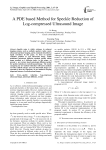
A PDE based Method for Speckle Reduction of Log-compressed Ultrasound Image
Статья научная
Speckle noise is widely existence in coherent imaging systems, such as synthetic aperture radar, sonar, ultrasound and laser imaging, and is commonly described as signal correlated. In this paper, we focus on speckle reduction problem in real ultrasound image. Unlike traditional anisotropic diffusion methods usually taking image gradient as a diffusion index, in this paper, we present a new texture based anisotropic diffusion method for speckle reduction in real ultrasound image. The results comparing our new method with other well known methods on both synthetic images and real ultrasound images are reported to show the superiority of our method in keeping important features of real ultrasound images.
Бесплатно
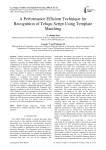
A Performance Efficient Technique for Recognition of Telugu Script Using Template Matching
Статья научная
Feature extraction and classification processes while developing Optical Character Recognition (OCR) systems involve massive computations and quite expensive especially for South Indian scripts. Multiple combinations of vowels and consonants along with its modifiers led to generation of huge number of classes with respect to character recognition systems. The feature extraction and classification of characters from such huge number of classes in south Indian language OCRs remains as a non-trivial problem. This paper proposes a technique for feature extraction and classification of Telugu handwritten script based on customized template matching approach with the support of caching technique for better performance. The technique of caching is implemented using main database with a cache database maintaining the frequently used character templates for set of all character templates. The XML database is used for defining the classes for various character templates and the class representations are provided using a novel class structure designed based on XML tags. The proposed system exhibits the recognition efficiency on our own test dataset with an overall accuracy of 83.55% for handwritten characters.
Бесплатно
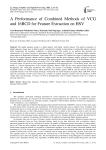
A Performance of Combined Methods of VCG and 16BCD for Feature Extraction on HSV
Статья научная
The digital signature image is a digital pattern with highly variable features. The pattern recognition of digital signature images aims to build a specific characteristic capable of representing a considerable pattern variation while maintaining the boundary conditions of authentication. The feature as an attribute that describes the characteristics of a pattern becomes a determinant factor of reliability of a method of recognizing digital signature image pattern for Handwritten Signature Verification (HSV). To construct HSV required two types of signature samples that are the original signature samples used as training samples and the guess signature samples (consist of valid and imposter signature) which are used as test samples. This study proposes two unique features of 16-Bits Binary Chain to Decimal (16BCD) and Virtual Center of Gravity (VCG). The 16BCD feature obtained from image segmentation with a 4x4 pixel region. All pixels in each region of the segmentation result rearranged into a 16-bit binary chain. The VCG feature is a virtual representation of the Original Signature Pattern (OSP) gravity center against Pattern Space and Background. The verification mechanism uses criteria: the percent of acceptable correlation coefficients for the acceptable feature of 16BCD feature, Mean Absolute Error (MAE) against 16BCD, and the percent deviation of acceptable distance to the VCG feature prototype. Verification test results obtained Acceptance Rate (AR) 80% (which states the percentage of HSV success based on a number of original signature samples) with an efficiency of 90% (which states the percentage of success of HSV in distinguishing valid or forgery signature based on a sample of guessing signatures).
Бесплатно
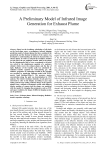
A Preliminary Model of Infrared Image Generation for Exhaust Plume
Статья научная
Based on the irradiance calculation of all pixels on the focal plane array, a preliminary infrared imaging prediction model of exhaust plume that have considered the geometrical and the thermal resolution of the camera was developed to understanding the infrared characteristics of exhaust plume. In order to compute the irradiance incident on each pixel, the gas radiation transfer path in the plume for the instantaneous field of view corresponds to the pixel was solved by the simultaneous equation of a enclosure cylinder which covers the exhaust plume and the line of sight. Radiance of the transfer path was calculated by radiation transfer equation for nonscattering gas. The radiative properties of combustion needed in the equation was provided by employing Malkmus model with EM2C narrow band database(25cm-1). The pressure, species concentration along the path was determination by CFD analysis. The relative irradiance intensity of each pixel was converted to color in the display according to gray map coding and hot map coding. Infrared image of the exhaust plumes from a subsonic axisymmetric nozzle with different relative position of camera and the plume was predicted with the model. By changing the parameters, such as FOV and space resolution, the image of different imaging system can be predicted.
Бесплатно

A Progressive Image Transmission Method Based on Discrete Wavelet Transform (DWT)
Статья научная
In this paper, a wavelet-based progressive image transmission (PIT) scheme is proposed. Here a combined method is proposed to reduce the image browsing time. The proposed scheme transforms a digital image from spatial domain into frequency domain by using discrete wavelet transformation. For wavelet transformation phase we have used Haar wavelet transformation. But it is computationally rigorous. Using concurrent computing we have significantly reduced computation time overhead as well as transmission time. According to the experimental results, the proposed scheme provides the accuracy of reconstructed image and the image browsing time reduces significantly.
Бесплатно
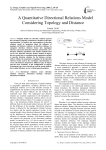
A Quantitative Directional Relations Model Considering Topology and Distance
Статья научная
Original models for direction relations ignored the restriction of topology and distance relations to direction representation. To improve the representation of direction relations model by pondering about the influence of topology and distance relations on direction relations, we categorize direction reference frame into topological reference and coarse directions reference and present a new direction relations quantitative and statistics models based on the new direction reference frames. Instead of degree, this new model uses a coordinate-based quantitative method to describe direction relations for the distance restrain, while it reflects the constraints of topology by the direction reference frame and by the coordinate representation. It covers all intricacies imposed by different types of objects and has more sensitivity to the configuration of objects. Experiments have been carried out and the results indicate the excellent efficiency in view of directional description.
Бесплатно
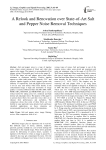
A Relook and Renovation over State-of-Art Salt and Pepper Noise Removal Techniques
Статья научная
Salt and pepper noise is a type of impulse noise, where certain amount of black and white dots appear in the image. The intensity is accumulated in 8 bit integer, giving 256 possible gray levels in the range (0 – 255).In this range salt and pepper noise takes either minimum or maximum intensity. Positive impulse appears as white (salt) points with intensity '255' and negative impulse appears as black (pepper) points with intensity '0' respectively. Salt and pepper noise removal is not an easy task mostly when noise density in the contaminated image is high and restoration of image quality is essential. Different filters like MF, SMF, AMF, PSMF, DBA, DBUTMF, and MDBUTMF and so on are noticed useful for taking away low, moderate and high density salt and pepper noise. The purpose of this paper is to present these filters first and then revise their art to enhance their performances and usefulness. The comparison shows that some of these filters are very fruitful in some particular noise density levels and hence classified applications on these situations are recommended based on the output of investigations.
Бесплатно
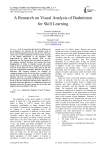
A Research on Visual Analysis of Badminton for Skill Learning
Статья научная
A lot of researches that detect the difference of the proficiency are reported for the dynamic scene of sports. Athlete population increases in late years. However, coach same as before population. In this research, it aimed at the helpful information in the beginner’s skill improvement by using the dynamic scene to play badminton for the clearing shot and aimed to acquire it. We compare standard deviation and average time from Ragging-back of stroke in beginner group and expert group to shot. It pretends and it compares it the detection of tracks of the joint part of the racket head to the shot from the Lagging-back beginning. Beginner and expert’s difference and common features are clarified by comparing images of the shot in the there is a shuttle state and the state of pretense. As a result, the feature and the beginner who drew yen while swinging to expert’s tracks got the feature such as gradual seen from the lowest part of tracks to the shot compared with the expert. Moreover, it has been understood that there is a difference between the beginner group and the expert group also at the time that hangs the shot and stability of the shot.
Бесплатно
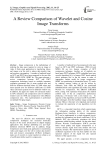
A Review Comparison of Wavelet and Cosine Image Transforms
Статья научная
Image compression is the methodology of reducing the data space required to store an image or video. It finds great application in transferring videos and images over the web to reduce data transfer time and resource consumption. A number of methods based on DCT and DWT have been proposed in the past like JPEG, MPEG, EZW, SPIHT etc. The paper presents a review comparison between DCT and DWT compression techniques based on multiple important evaluation parameters like (i) mean squared error and SNR for different threshold values (ii) SNR values and mean squared error for different coefficients (iii) SNR values and mean squared error for different window size. In addition, the paper also makes two advanced studies (i) CPU utilization and compression ratio for different window sizes (ii) SNR and compression with different compression ratio. The experimentation is performed on multiple 8x8 jpeg images.
Бесплатно
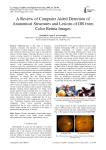
Статья научная
Ophthalmology is the study of structures, functions, treatment and disorders of eye. Computer aided analysis of retina images is still an open research area. Numerous efforts have been made to automate the analysis of retina images. This paper presents a review of various existing research in detection of anatomical structures in retina and lesions for the diagnosis of diabetic retinopathy (DR). The research in detection of anatomical structures is further divided into subcategories, namely, vessel segmentation and vessel centerline extraction, optic disc segmentation and localization, and fovea/ macula detection and extraction. Various research works in each of the categories are reviewed highlighting the techniques employed and comparing the performance figures obtained. The issues/ lacuna of various approaches are brought out. The following major observations are made: Most of the vessel detection algorithms fail to extract small thin vessels having low contrast. It is difficult to detect vessels at regions where close vessels are merged, at regions of missing of small vessels, at optic disc regions, and at regions of pathology. Machine learning based approaches for blood vessel tracing requires long processing time. It is difficult to detect optic disc radius or boundary with simple blood vessel tracing. Automatic detection of fovea and macular region extraction becomes complicated due to non-uniform illuminations while imaging and diseases of the eyes. Techniques requiring prior knowledge leads to complexity. Most lesion detection algorithms underperform due to wide variations in the color of fundus images arising out of variations in the degree of pigmentation and presence of choroid.
Бесплатно
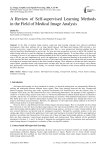
A Review of Self-supervised Learning Methods in the Field of Medical Image Analysis
Статья научная
In the field of medical image analysis, supervised deep learning strategies have achieved significant development, while these methods rely on large labeled datasets. Self-Supervised learning (SSL) provides a new strategy to pre-train a neural network with unlabeled data. This is a new unsupervised learning paradigm that has achieved significant breakthroughs in recent years. So, more and more researchers are trying to utilize SSL methods for medical image analysis, to meet the challenge of assembling large medical datasets. To our knowledge, so far there still a shortage of reviews of self-supervised learning methods in the field of medical image analysis, our work of this article aims to fill this gap and comprehensively review the application of self-supervised learning in the medical field. This article provides the latest and most detailed overview of self-supervised learning in the medical field and promotes the development of unsupervised learning in the field of medical imaging. These methods are divided into three categories: context-based, generation-based, and contrast-based, and then show the pros and cons of each category and evaluates their performance in downstream tasks. Finally, we conclude with the limitations of the current methods and discussed the future direction.
Бесплатно
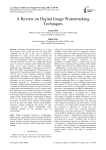
A Review on Digital Image Watermarking Techniques
Статья научная
Nowadays, Multimedia security [1] is a major issue. Images, video, audio, text files are losing their credibility day by day as they can be distorted or manipulated by using several tools. Ensuring the authenticity [2] and integrity of digital media is a major issue. The manipulation made by forgery tools are so smoothly done that we don’t even suspect that forgery may be involved in digital content. Multimedia data is facing several issues related to illegal distribution, duplication and manipulation of information conveyed by them. The digital watermarking [3] technique plays an important role in protecting digital content. In this paper, On the basis of their operating principles different watermarking techniques are categorized [4]. Attacks, applications and requirements [5] related to watermarking techniques are also discussed. Different watermarking techniques proposed by researchers for protecting copyrights of digital media are presented which are based on spatial and frequency domain. Frequency domain are getting much more attention due to use of wavelets which have high degree of resemblance to human visual system. In digital watermarking, secret information is embedded with original data for maintaining ownership rights of the digital content. Spatial domain watermarking techniques work over pixel characteristics and frequency domain watermarks concerned about different transformations that can be used with digital content. Imperceptibility, robustness, security, complexity and capacity are some requirements of the digital watermarking which completely depends on the algorithm used for watermarking.
Бесплатно
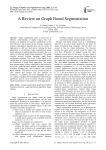
A Review on Graph Based Segmentation
Статья научная
Image segmentation plays a crucial role in effective understanding of digital images. Past few decades saw hundreds of research contributions in this field. However, the research on the existence of general purpose segmentation algorithm that suits for variety of applications is still very much active. Among the many approaches in performing image segmentation, graph based approach is gaining popularity primarily due to its ability in reflecting global image properties. This paper critically reviews existing important graph based segmentation methods. The review is done based on the classification of various segmentation algorithms within the framework of graph based approaches. The major four categorizations we have employed for the purpose of review are: graph cut based methods, interactive methods, minimum spanning tree based methods and pyramid based methods. This review not only reveals the pros in each method and category but also explores its limitations. In addition, the review highlights the need for creating a database for benchmarking intensity based algorithms, and the need for further research in graph based segmentation for automated real time applications.
Бесплатно
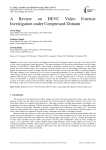
A Review on HEVC Video Forensic Investigation under Compressed Domain
Статья научная
In recent years, video forensic investigation has become a prominent research area, due to the adverse effect of fake videos on networks, people and society. This paper summarizes all the existing methodologies used for forgery detection in H.265/HEVC videos. HEVC video forgery is generally classified into two categories as video quality forgery and video content forgery. The occurrence of various forgeries such as transcoding, fake-bitrate, inter-frame forgery and intra-frame forgery is deeply analyzed based on features extracted from the HEVC compression domain. The major findings of this research are (i) Less focus on transcoding detection, (ii) Non-availability of HEVC forged video dataset (iii) More focus on double compression detection for forgery detection, and (iv) Non-consideration of adaptive-GOP structure. The forgery detection in the video is critically important due to its wide use as the primary source of information in criminal investigations and proving the authenticity of contents. So, the forgery detection accuracy is of major concern at the present time. Although, various forgery detection methods are developed in past but the findings of this review point out the need of developing more effective detection methods with high accuracy.
Бесплатно
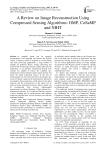
A Review on Image Reconstruction Using Compressed Sensing Algorithms: OMP, CoSaMP and NIHT
Статья научная
A sampled signal can be properly reconstructed if the sampling rate follows the Nyquist criteria. If Nyquist criteria is imposed on various image and video processing applications, a large number of samples are produced. Hence, storage, processing and transmission of these huge amounts of data make this task impractical. As an alternate, Compressed Sensing (CS) concept was applied to reduce the sampling rate. Compressed sensing method explores signal sparsity and hence the signal acquisition process in the area of transformation can be carried out below the Nyquist rate. As per CS theory, signal can be represented by alternative non-adaptive linear projections, which preserve the signal structure and the reconstruction of the signal can be achieved using optimization process. Hence signals can be reconstructed from severely undersampled measurements by taking advantage of their inherent low-dimensional structure. As Compressed Sensing, requires a lower sampling rate for reconstruction, data captured within the specified time will be obviously less than the traditional method. In this paper, three Compressed Sensing algorithms, namely Orthogonal Matching Pursuit (OMP), Compressive Sampling Matching Pursuit (CoSaMP) and Normalized Iterative Hard Thresholding (NIHT) are reviewed and their performance is evaluated at different sparsity levels for image reconstruction.
Бесплатно
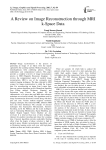
A Review on Image Reconstruction through MRI k-Space Data
Статья научная
Image reconstruction is the process of generating an image of an object from the signals captured by the scanning machine. Medical imaging is an interdisciplinary field combining physics, biology, mathematics and computational sciences. This paper provides a complete overview of image reconstruction process in MRI (Magnetic Resonance Imaging). It reviews the computational aspect of medical image reconstruction. MRI is one of the commonly used medical imaging techniques. The data collected by MRI scanner for image reconstruction is called the k-space data. For reconstructing an image from k-space data, there are various algorithms such as Homodyne algorithm, Zero Filling method, Dictionary Learning, and Projections onto Convex Set method. All the characteristics of k-space data and MRI data collection technique are reviewed in detail. The algorithms used for image reconstruction discussed in detail along with their pros and cons. Various modern magnetic resonance imaging techniques like functional MRI, diffusion MRI have also been introduced. The concepts of classical techniques like Expectation Maximization, Sensitive Encoding, Level Set Method, and the recent techniques such as Alternating Minimization, Signal Modeling, and Sphere Shaped Support Vector Machine are also reviewed. It is observed that most of these techniques enhance the gradient encoding and reduce the scanning time. Classical algorithms provide undesirable blurring effect when the degree of phase variation is high in partial k-space. Modern reconstructions algorithms such as Dictionary learning works well even with high phase variation as these are iterative procedures.
Бесплатно

